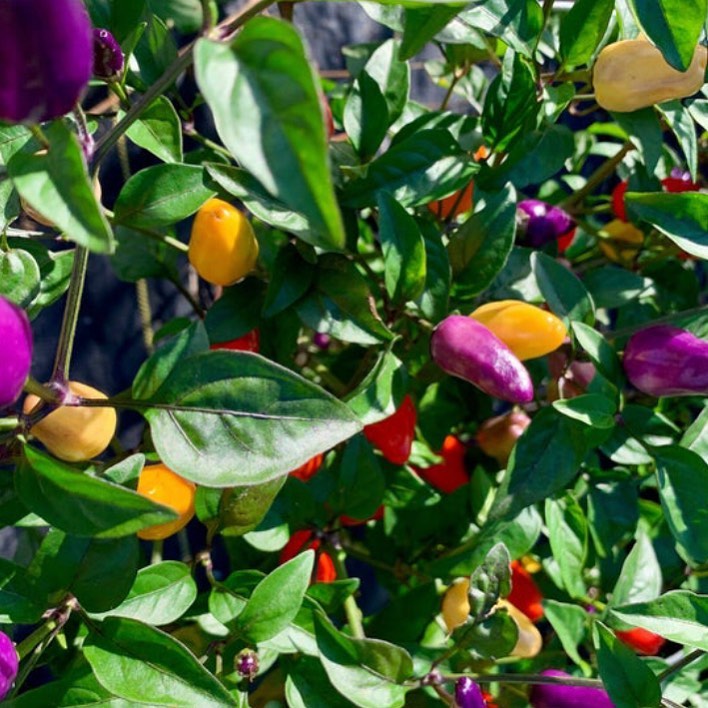Beginners Guide to Growing Peppers
April 21, 2021
This guide is intended as a quick reference for new beginning gardeners, if you are looking for an in-depth dive into growing peppers. Check out my other blog post that dives into the complexity of growing peppers.
Table of Contents:- Materials
- When to Grow
- Germination
- Growing Conditions
- Hardening Off
- In the Garden
- Growing Peppers In The Garden
________________________________________________________________
Materials
Some things you will need to begin growing your peppers:
- Soil/Peat Pellets/ Growing Medium
- Seed Cells/ Container to Grow
- Labels/ Painters Tape
- Marker
- Grow Light/South Facing Window
- Seeds
Optional:
- Spray Bottle
- Plastic Bag
- Paper Towel
________________________________________________________________
Germination
Germinating your seeds can prove challenging for some gardeners, however with the right process it is nothing to fear.
There are two options when it comes to germination
The Bag Method OR In Soil Germination
I will explain both,
The Bag Method consists of placing your pepper seeds in a damp paper towel, then into a plastic bag. Leave to sit for about a week on a slightly warm surface, such as the top of a refrigerator or on top of a grow light. Once seeds begin to send out a root stem (small white arm) you can transplant them into the soil. This method allows you to see what seeds germinate and not waste time or space on dead seeds.
(Example of root growth using the bag method)
Light is NOT necessary to germinate your pepper seeds.
The second and more common method of germinating pepper seeds is simply placing them in your seed cells on the top layer of dirt, and adding another small layer on top. It is important to constantly spray your seeds to ensure they do not dry out. This method is far more simple than others, and works well for most.
________________________________________________________________
When to Grow
This varies a lot depending on WHERE you are growing and WHAT you are growing.
In general it is a good idea to find your last frost date as well as average temperatures for the spring months.
In general, super hot chilies such as the scotch bonnet or habanero should be planted 3-4 months before your last frost date.
Most other chilies such as red chilies or mini-sweet peppers should be planted 2-3 months before last frost date.
Listed are the dates for all varieties
C.pubescens 4 months
C.chinense 3-4 months
C.baccatum 3 months
C.frutescens 3 months
C.annuum 2-3 months
________________________________________________________________
Growing Conditions
Pots
Peppers, as well as other seeds, can be grown in a variety of containers. I would recommend starting your peppers in either seedling sets/ trays or directly into 4 inch pots.
As long as the soil can properly drain out of the containers, you will be able to grow your seedlings.
As well, you may purchase 6 inch or larger pots, in the event you need to pot-up your pepper before you can transplant into the garden.
Growing Medium
You can grow seeds in a variety of growing mediums, however peat pods and soil are recommended for most growers, especially if you are just starting out.
Make sure to use a potting mix soil or seedling mix to ensure well draining soil. Make sure to lightly moisten the soil before placing your germinated seeds in it.
Once the seeds are in the soil and covered, keep slightly damp until they sprout. Once the seeds begin to grow above the soil, try to bottom water as much as possible. You do not want to keep the soil damp 100% of the time, or it can cause " dampening off". Where by the damp soil can rot the stem of the young pepper seedling, thus killing it.

________________________________________________________________
Grow Lights
The best option for most gardeners is LED grow lights. Not only are they more efficient, resulting in less heat and excess energy use. They traditionally last longer than other types of grow lights.
Grow lights can have many different stats, such as Watts referring to the power of the light, Kelvin referring to the colour of the light, and lumens referring to the brightness/intensity of the light.
In general a grow light in the 80-100 lumen range with around 250 Watts, should be fine to grow pepper seedling.
Selecting a light to grow seedlings is far less complex than selecting a grow light, if you intend to mature and fruit the peppers under the light.
As well, you may find some lights are purple, while others are a white colour and advertise "Full Spectrum", this simply means they can support the full range of light needed to grow a pepper plant fully. For growing seedlings, purple LEDs will suffice, however they may make it harder to identify issues on the plant.
Make sure to place the light 2-4 inches above the seedlings when they first sprout and gradually increase the height. Making sure to keep the light close enough to prevent your seedlings from becoming "leggy". Where they stretch too fast for the light and become tall and flimsy. It is recommended to keep the light 8-12 inches above the larger seedlings.
Another alternative to grow lights is simply leaving your peppers on a windowsill to collect natural sunlight. While this method definitely works, you will need a south facing window and your seedlings will not grow as large.

________________________________________________________________
Hardening Off
Transplanting may take place while the peppers are still indoors, which involves potting the peppers into larger plants to prevent root bounding. This is when the roots coil inside a small container and stress the plant out.
In terms of transplanting outdoors however, you will need to "harden off" your seedlings. Once the temperature is above 60'f (15'c), and the chance of frost has passed you should begin to harden off your peppers.
Hardening off involves acclimating your seedling, which have been growing under a grow light that lacks the strength of the sun's UV rays, to the sun and the colder temperatures.
Hardening off seedlings is a critical part to prevent the plants from dying due to shock. Pick an overcast day if possible and begin to bring the plants out into the shade, for 1 hour. Then bring the plants back in and repeat for a week. Slowly bringing the plants into more direct sunlight for longer periods of time.
If done correctly over the course of a week your peppers should be able to be transplanted into the garden.
If you notice severe wilting or sun damage, simply bring the peppers in and try again the next day with less direct sun.
________________________________________________________________
Planting in the garden
Your plants are hardened off and ready to be planted, the next step is to find a suitable spot for them. Space peppers 2 feet center to center, meaning the centers of the plant should be at least 2 feet apart.
Peppers love sun and should be planted in an area that that receives a lot of it. Water once every few days, especially when the weather is hot. Peppers enjoy a lot of water, but can suffer from overwatering (yellowing of the leaves) if given too much.
Peppers enjoy soil rich in organic material and nitrogen, such as compost.

________________________________________________________________
Growing Peppers in the Garden
Once your peppers are planted, you may choose to add supports or stakes to them. However this is not always required as most peppers can support themselves. Keep an eye out for pests and diseases, and remember google is your friend when it comes to peppers.
Now simply wait around 80 to 100 days and you should have fresh, bright, homegrown peppers.
Enjoy!


